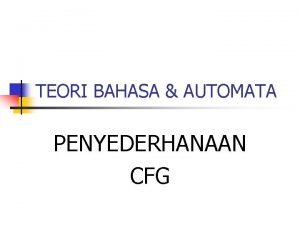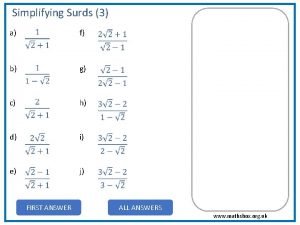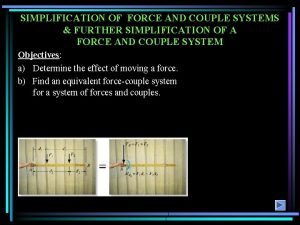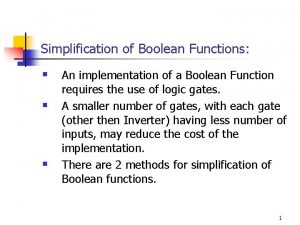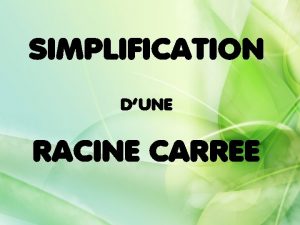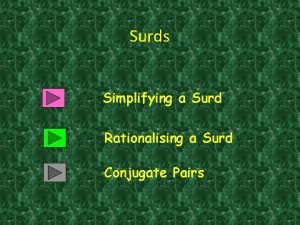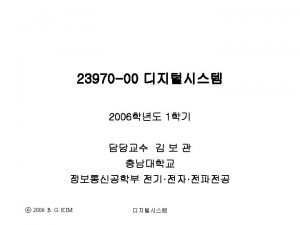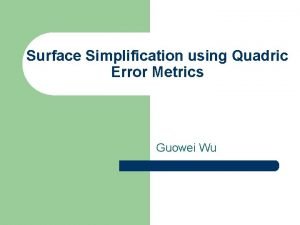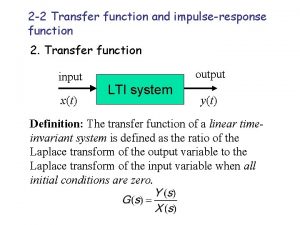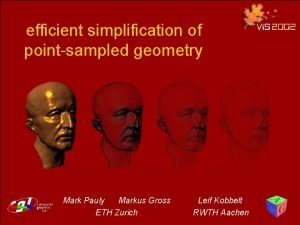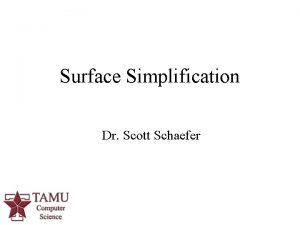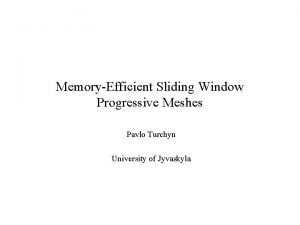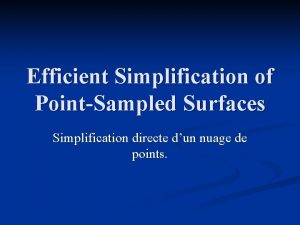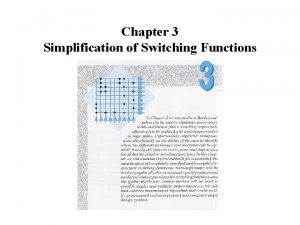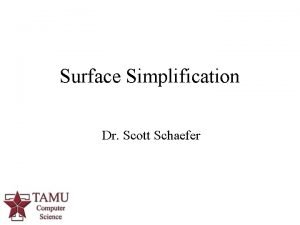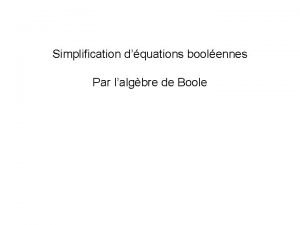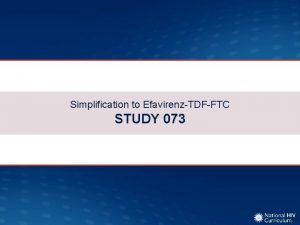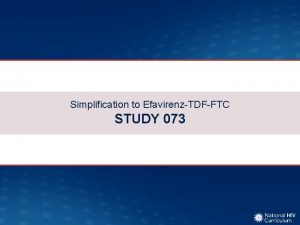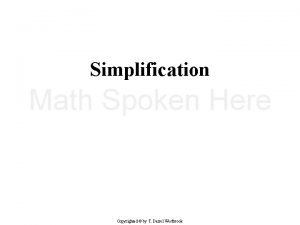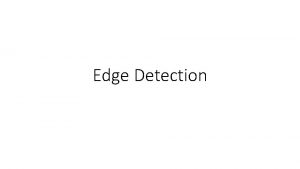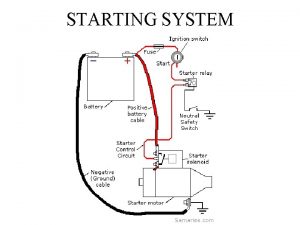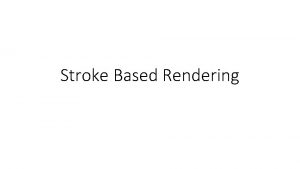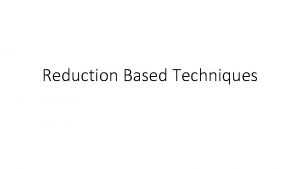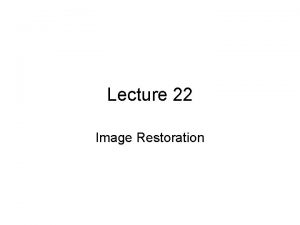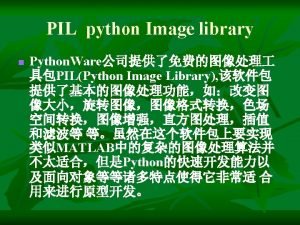Image Simplification Starting project Use the starting project




















![Symmetric nearest neighbor filter – C# script [Execute. In. Edit. Mode] [Require. Component(typeof(Camera))] public Symmetric nearest neighbor filter – C# script [Execute. In. Edit. Mode] [Require. Component(typeof(Camera))] public](https://slidetodoc.com/presentation_image/2eef69d5d8c1ddbc09e91bf1a37d76f0/image-21.jpg)







![Kuwahara filter – C# script [Execute. In. Edit. Mode] [Require. Component(typeof(Camera))] public class Kuwahara. Kuwahara filter – C# script [Execute. In. Edit. Mode] [Require. Component(typeof(Camera))] public class Kuwahara.](https://slidetodoc.com/presentation_image/2eef69d5d8c1ddbc09e91bf1a37d76f0/image-29.jpg)







![Luminance quantization – C# script [Execute. In. Edit. Mode] [Require. Component(typeof(Camera))] public class Quantization Luminance quantization – C# script [Execute. In. Edit. Mode] [Require. Component(typeof(Camera))] public class Quantization](https://slidetodoc.com/presentation_image/2eef69d5d8c1ddbc09e91bf1a37d76f0/image-37.jpg)






- Slides: 43

Image Simplification

Starting project • Use the starting project of this practical – Pr 05 -Image. Simplification. Base. Project. zip • Contains the Post. Effects. Base base class for image effects from last week • Open the base unity scene: • Lab 05/Lab 05 -Scene. unity

Edge preserve smoothing - Bilateral filter • Recall: bilateral filter uses two Gaussian weights: • One weight for distance from center pixel • One weight for the pixel value difference • The two weights are multiplied • Lets start with a single Gaussian filter • Create a new C# script and Image Effect Shader • Call them Bilateral. Filter and Bilateral. Filter. Shader • Change the shader name in the shader code (first row) Shader "NPR/Bilateral. Filter" { Properties //. . .

Bilateral filter – C# script • Use the Post. Effects. Base base class • Find the shader and create the material in the Start function [Execute. In. Edit. Mode] [Require. Component(typeof(Camera))] public class Bilateral. Filter : Post. Effects. Base { [Range(0, 5. 0 f)] public float sigma. Distance = 1. 0 f; void Start () { shader = Shader. Find("NPR/Bilateral. Filter"); Create. Material(); } // see next slide for On. Render. Image } User-controlled smooth strength

Bilateral filter – C# script • On. Render. Image refreshes the material if needed and passes the threshold to the shader void On. Render. Image(Render. Texture source, Render. Texture destination) { if (Create. Material()) { material. Set. Float("sigma", sigma. Distance); Graphics. Blit(source, destination, material); } else { Graphics. Blit(source, destination); } }

Bilateral filter – Shader "NPR/Bilateral. Filter" { Properties { _Main. Tex("Texture", 2 D) = "white" {} } Sub. Shader { // No culling or depth Cull Off ZWrite Off ZTest Always Pass { CGPROGRAM #pragma vertex vert #pragma fragment frag #include "Unity. CG. cginc"

struct appdata { float 4 vertex : POSITION; float 2 uv : TEXCOORD 0; }; Bilateral filter – Shader struct v 2 f { float 2 uv : TEXCOORD 0; float 4 vertex : SV_POSITION; }; v 2 f vert(appdata v) { v 2 f o; o. vertex = Unity. Object. To. Clip. Pos(v. vertex); o. uv = v. uv; return o; } sampler 2 D _Main. Tex; float 4 _Main. Tex_Texel. Size; float sigma; float Gauss(float d, float sigma) { return 1. 0 / (sigma*sqrt(2. 0*3. 14)) * exp((-d*d) / (2. 0*sigma)); }

Bilateral filter – Shader float 4 frag(v 2 f i) : SV_Target { float 3 SUM = float 3(0, 0, 0); float SUMW = 0; if (sigma == 0) SUM = tex 2 D(_Main. Tex, i. uv). rgb; else { for (int iy = -5; iy <= 5; iy++) for (int ix = -5; ix <= 5; ix++) { float 2 uv = i. uv + _Main. Tex_Texel. Size. xy * float 2(ix, iy); float 3 col = tex 2 D(_Main. Tex, uv). rgb; float w = Gauss(length((i. uv - uv) / _Main. Tex_Texel. Size. xy), sigma); SUMW += w; SUM += col*w; } SUM /= SUMW; } return float 4(SUM, 1); } ENDCG } } }

Bilateral filter • Attach the script to the main camera and try it! • This is just a simple Gaussian blur yet! sigma = 1. 0 sigma = 2. 88

Bilateral filter – value weighting – C# script • Add sigma parameter for value difference [Range(0, 2. 0 f)] public float sigma. Value = 1. 0 f; • Pass parameter value to shader void On. Render. Image(Render. Texture source, Render. Texture destination) { if (Create. Material()) { material. Set. Float("sigma", sigma. Distance); material. Set. Float("sigma. Distance", sigma. Distance); material. Set. Float("sigma. Value", sigma. Value); Graphics. Blit(source, destination, material); }

sampler 2 D _Main. Tex; float 4 _Main. Tex_Texel. Size; float sigma. Distance; float sigma. Value; Bilateral filter – value weighting Shader float 4 frag(v 2 f i) : SV_Target { float 3 SUM = float 3(0, 0, 0); float SUMW = 0; if (sigma == 0) if (sigma. Distance * sigma. Value == 0) SUM = tex 2 D(_Main. Tex, i. uv). rgb; else { float 3 col 0 = tex 2 D(_Main. Tex, i. uv). rgb; for (int iy = -5; iy <= 5; iy++) for (int ix = -5; ix <= 5; ix++) { float 2 uv = i. uv + _Main. Tex_Texel. Size. xy * float 2(ix, iy); float 3 col = tex 2 D(_Main. Tex, uv). rgb; float w = Gauss(length((i. uv - uv) / _Main. Tex_Texel. Size. xy), sigma); float wd = Gauss(length((i. uv - uv) / _Main. Tex_Texel. Size. xy), sigma. Distance); float wv = Gauss(length(col-col 0), sigma. Value); float w = wd*wv; SUMW += w; …

Bilateral filter • Try it! • sigma. Value basically determines how strong edges are kept sigma. Distance = 4. 33 sigma. Value = 1. 58 sigma. Distance = 4. 33 sigma. Value = 0. 61

Separable Bilateral Filter • Though Bilateral filter is not separable, we can try to use it as a separable filter • Need two passes: one filters in x direction, one in y direction • C# script: void On. Render. Image(Render. Texture source, Render. Texture destination) { if (Create. Material()) { Render. Texture tmp = Render. Texture. Get. Temporary(source. width, source. height, 0, Render. Texture. Format. Default. HDR); material. Set. Float("sigma. Distance", sigma. Distance); material. Set. Float("sigma. Value", sigma. Value); material. Set. Int("filter. Dir", 0); Graphics. Blit(source, tmp, material); material. Set. Int("filter. Dir", 1); Graphics. Blit(tmp, destination, material); tmp. Release(); }

Separable Bilateral Filter - Shader float sigma. Value; int filter. Dir; float Gauss(float d, float sigma) { return 1. 0 / (sigma*sqrt(2. 0*3. 14)) * exp((-d*d) / (2. 0*sigma)); } float 4 frag(v 2 f i) : SV_Target { float 2 dir = filter. Dir == 0 ? float 2(1, 0) : float 2(0, 1); float 3 SUM = float 3(0, 0, 0); float SUMW = 0; if (sigma. Distance * sigma. Value == 0) SUM = tex 2 D(_Main. Tex, i. uv). rgb; else { float 3 col 0 = tex 2 D(_Main. Tex, i. uv). rgb; for (int ix = -5; ix <= 5; ix++) { float 2 uv = i. uv + _Main. Tex_Texel. Size. xy * dir * float(ix); Single loop!

Separable Bilateral filter • Try it! • Similar quality!

Iterative Separabe Bilateral filter C# • To have larger blurs, it can be more efficient to run the filter multiple times instead of using larger kernel sizes [Range(0, 5. 0 f)] public float sigma. Distance = 1. 0 f; [Range(0, 2. 0 f)] public float sigma. Value = 1. 0 f; public int iterations = 1;

Iterative Separabe Bilateral filter C# void On. Render. Image(Render. Texture source, Render. Texture destination) { if (Create. Material()) { Render. Texture tmp = Render. Texture. Get. Temporary(source. width, source. height, 0, Render. Texture. Format. Default. HDR); Render. Texture rt 1 = source; Render. Texture rt 2 = tmp; for (int i = 0; i < iterations; ++i) { material. Set. Float("sigma. Distance", sigma. Distance); material. Set. Float("sigma. Value", sigma. Value); material. Set. Int("filter. Dir", 0); Graphics. Blit(rt 1, rt 2, material); material. Set. Int("filter. Dir", 1); if (i == iterations - 1) rt 1 = destination; Graphics. Blit(rt 2, rt 1, material); } tmp. Release(); }

Iterative Separabe Bilateral filter C# • Try it! 10 iterations

Symmetric nearest neighbor filter (SNN) P 1 P 2 P 3 P 4 P 5 P 6 P 7 P 8 P 9 P 10 P 11 P 12 P 13 P 14 P 15 P 16 P 17 P 18 P 19 P 20 P 21 P 22 P 23 P 24 P 25 • Visit pixel pairs on opposite directions • Choose the pixel from the pair, which is closer (in value) to center pixel (P 13) • Take the average of closer pixels for all pairs D. Harwood, M. Subbarao, H. Hakalahti, and L. S. Davis: A New Class Of Edge-Preserving Smoothing Filters PRL Vol. 6, pp. 155 -162, 1987.

Symmetric nearest neighbor filter • Create a new C# script and Image Effect Shader • Call them SNNFilter and SNNFilter. Shader • Change the shader name in the shader code (first row) Shader "NPR/SNNFilter" { Properties //. . .
![Symmetric nearest neighbor filter C script Execute In Edit Mode Require ComponenttypeofCamera public Symmetric nearest neighbor filter – C# script [Execute. In. Edit. Mode] [Require. Component(typeof(Camera))] public](https://slidetodoc.com/presentation_image/2eef69d5d8c1ddbc09e91bf1a37d76f0/image-21.jpg)
Symmetric nearest neighbor filter – C# script [Execute. In. Edit. Mode] [Require. Component(typeof(Camera))] public class SNNFilter : Post. Effects. Base { public int filter. Size = 5; void Start() { shader = Shader. Find("NPR/SNNFilter"); Create. Material(); } void On. Render. Image(Render. Texture source, Render. Texture destination) { if (Create. Material()) { material. Set. Int("filter. Size", filter. Size); Graphics. Blit(source, destination, material); } else { Graphics. Blit(source, destination); } } }

sampler 2 D _Main. Tex; float 4 _Main. Tex_Texel. Size; int filter. Size; SNN filter – Shader float 4 frag (v 2 f i) : SV_Target { int N = filter. Size; //Inverse of the number of pixels pairs we are going to visit //It will be needed for taking the average float Pcount. Inv = 1. 0 / float((2 * N + 1)*N + N); //Read the center pixel value in the filter window float 3 PCenter = tex 2 D(_Main. Tex, i. uv). rgb; float 3 AVG = float 3(0, 0, 0); //SNN filter reads pair of pixels in filter window //The pairs are pixels mirrored to the filter origin //Thus we only have to loop the half of the filter window for (int iy = -N; iy <= 0; iy++) for (int ix = -N; ix <= N; ix++) { … next slide } AVG *= Pcount. Inv; //take the average of the more similar pixel values return float 4(AVG, 1); }

SNN filter – Shader for (int iy = -N; iy <= 0; iy++) for (int ix = -N; ix <= N; ix++) { if (iy == 0 && ix == 0)//if we reached the half of the filter window { ix = N + 1; iy = 1; break; //quit the double loop } //sample the pixel and its mirrored pair float 3 P 1 = tex 2 D(_Main. Tex, i. uv + _Main. Tex_Texel. Size. xy*float 2( ix, iy)). rgb; float 3 P 2 = tex 2 D(_Main. Tex, i. uv + _Main. Tex_Texel. Size. xy*float 2(-ix, -iy)). rgb; float 3 min. P = P 1; //Compute pixel value difference from center pixel float D 1 = length(P 1 - PCenter); float D 2 = length(P 2 - PCenter); //choose the pixel which is more similar to center pixel if (D 2 < D 1) min. P = P 2; AVG += min. P; }

SNN filter • Attach the script to the main camera and try it! • First disable or remove Bilateral Filter image effect component

Iterative SNN Filter void On. Render. Image(Render. Texture source, Render. Texture destination) { if (Create. Material()) { Render. Texture tmp = Render. Texture. Get. Temporary(source. width, source. height, 0, Render. Texture. Format. Default. HDR); Render. Texture rt 1 = source; //reference to source render texture Render. Texture rt 2 = tmp; //reference to destination render texture material. Set. Int("filter. Size", filter. Size); for (int i = 0; i < iterations; ++i) { if (i == iterations - 1) //in the last iteration rt 2 = destination; //the destination texture should be the final destination Graphics. Blit(rt 1, rt 2, material); //swap the two render textures Render. Texture t = rt 2; rt 2 = rt 1; rt 1 = t; } tmp. Release(); } else { Graphics. Blit(source, destination); } }

Iterative SNN filter • Try it! Filtersize 5 4 iterations

Kuwahara filter P 1 P 2 P 3 P 1 P 2 P 3 P 4 P 5 P 6 P 4 P 5 P 6 P 7 P 8 P 9 P 7 P 8 P 9 R 1 = {P 1, P 2, P 4, P 5} R 2 = {P 2, P 3, P 5, P 6} R 3 = {P 4, P 5, P 7, P 8} R 4 = {P 5, P 6, P 8, P 9} • Divide pixel neighborhood to four rectangular sub regions: R 1, R 2, R 3, R 4 • Compute expected value and variance for all regions • ER 1 = ¼ * (P 1+P 2+P 3+P 4) • Var. R 1 = ¼ * (P 12+P 22+P 32+P 42) - ER 12 • Find region with minimum variance and replace P 5 with the expected value of this region

Kuwahara filter • Create a new C# script and Image Effect Shader • Call them Kuwahara. Filter and Kuwahara. Filter. Shader • Change the shader name in the shader code (first row) Shader "NPR/Kuwahara. Filter" { Properties //. . .
![Kuwahara filter C script Execute In Edit Mode Require ComponenttypeofCamera public class Kuwahara Kuwahara filter – C# script [Execute. In. Edit. Mode] [Require. Component(typeof(Camera))] public class Kuwahara.](https://slidetodoc.com/presentation_image/2eef69d5d8c1ddbc09e91bf1a37d76f0/image-29.jpg)
Kuwahara filter – C# script [Execute. In. Edit. Mode] [Require. Component(typeof(Camera))] public class Kuwahara. Filter : Post. Effects. Base { [Range(0, 20)] public int filter. Size = 5; void Start() { shader = Shader. Find("NPR/Kuwahara. Filter"); Create. Material(); } void On. Render. Image(Render. Texture source, Render. Texture destination) { if (Create. Material()) { material. Set. Int("filter. Size", filter. Size); Graphics. Blit(source, destination, material); } else { Graphics. Blit(source, destination); } } }

Kuwahara filter – Shader I. sampler 2 D _Main. Tex; float 4 _Main. Tex_Texel. Size; int filter. Size; float 4 frag (v 2 f I) : SV_Target { int N = filter. Size; //Kuwahara filter divides the filter window to four equal parts //Pcount. Inv is the inv number of pixels in one window part float Pcount. Inv = 1. 0 / float((N + 1)*(N + 1)); //First window region float 3 E 1 = float 3(0, 0, 0); //expected value of region float 3 E 1_2 = float 3(0, 0, 0); //expected squared value of region for (int i = -N; i <= 0; i++) for (int j = -N; j <= 0; j++) { float 3 P = tex 2 D(_Main. Tex, I. uv + _Main. Tex_Texel. Size. xy*float 2(i, j)). rgb; E 1 += P; E 1_2 += P*P; } E 1 *= Pcount. Inv; float V 1 = length(Pcount. Inv*E 1_2 - E 1*E 1); //variance of region

//Second window region float 3 E 2 = float 3(0, 0, 0); float 3 E 2_2 = float 3(0, 0, 0); for (int i = -N; i <= 0; i++) for (int j = 0; j <= N; j++) { float 3 P = tex 2 D(_Main. Tex, E 2 += P; E 2_2 += P*P; } E 2 *= Pcount. Inv; float V 2 = length(Pcount. Inv*E 2_2 //Third window region float 3 E 3 = float 3(0, 0, 0); float 3 E 3_2 = float 3(0, 0, 0); for (int i = 0; i <= N; i++) for (int j = 0; j <= N; j++) { float 3 P = tex 2 D(_Main. Tex, E 3 += P; E 3_2 += P*P; } E 3 *= Pcount. Inv; float V 3 = length(Pcount. Inv*E 3_2 - Kuwahara filter Shader II. I. uv + _Main. Tex_Texel. Size. xy*float 2(i, j)). rgb; E 2*E 2); I. uv + _Main. Tex_Texel. Size. xy*float 2(i, j)). rgb; E 3*E 3);

Kuwahara filter Shader III. //Fourth window region float 3 E 4 = float 3(0, 0, 0); float 3 E 4_2 = float 3(0, 0, 0); for (int i = 0; i <= N; i++) for (int j = -N; j <= 0; j++) { float 3 P = tex 2 D(_Main. Tex, I. uv + _Main. Tex_Texel. Size. xy*float 2(i, j)). rgb; E 4 += P; E 4_2 += P*P; } E 4 *= Pcount. Inv; float V 4 = length(Pcount. Inv*E 4_2 - E 4*E 4); //Find the region with least variance float 3 min. E = E 1; float min. V = V 1; if (V 2 < min. V) { min. E = E 2; min. V = V 2; } if (V 3 < min. V) { min. E = E 3; min. V = V 3; } if (V 4 < min. V) { min. E = E 4; min. V = V 4; } //Use the excepted value of the region with least variance return float 4(min. E, 1); } ENDCG

Kuwahara filter • Attach the script to the main camera and try it! • First disable or remove SNN Filter image effect component

Task • Make the Kuwahara filter iterative

Luminance quantization • Define N bins of luminance, and replace pixel luminance value with bin luminance • Need to convert to a color space with luminance channel (e. g. HSV or CIELab) • After quantization convert back to RGB Original luminance values 3 luminance bins can be implemented with floor() or step() 3 luminance with smooth transition can be implemented with smoothstep()

Luminance quantization • Create a new C# script and Image Effect Shader • Call them Quantization and Quantization. Shader • Change the shader name in the shader code (first row) Shader "NPR/Quantization" { Properties //. . .
![Luminance quantization C script Execute In Edit Mode Require ComponenttypeofCamera public class Quantization Luminance quantization – C# script [Execute. In. Edit. Mode] [Require. Component(typeof(Camera))] public class Quantization](https://slidetodoc.com/presentation_image/2eef69d5d8c1ddbc09e91bf1a37d76f0/image-37.jpg)
Luminance quantization – C# script [Execute. In. Edit. Mode] [Require. Component(typeof(Camera))] public class Quantization : Post. Effects. Base { [Range(1, 20)] public int levels = 5; void Start() { shader = Shader. Find("NPR/Quantization"); Create. Material(); } void On. Render. Image(Render. Texture source, Render. Texture destination) { if (Create. Material()) { material. Set. Int("levels", levels); Graphics. Blit(source, destination, material); } else { Graphics. Blit(source, destination); } } }

Luminance quantization – Shader CGPROGRAM #pragma vertex vert #pragma fragment frag #include "Unity. CG. cginc" #include ". . /Lab 03/colorspaces. cginc" … sampler 2 D _Main. Tex; int levels; float 3 frag (v 2 f i) : SV_Target { float 3 col = tex 2 D(_Main. Tex, i. uv). rgb; float 3 hsv = rgb_to_hsv(col); hsv. b = floor(hsv. b * levels) / float(levels); col = hsv_to_rgb(hsv); return float 4(col, 1); } ENDCG

Quantization • Attach the script to the main camera and try it! • We can disable previous effects.

Quantization with smooth transitions • Add new variable to C# script public class Quantization : Post. Effects. Base { [Range(1, 20)] public int levels = 5; [Range(0, 1)] public float transition. Sharpness = 0. 8 f; void On. Render. Image(Render. Texture source, Render. Texture destination) { if (Create. Material()) { material. Set. Int("levels", levels); material. Set. Float("transition. Sharpness", transition. Sharpness); Graphics. Blit(source, destination, material); }

Quantization with smooth transitions - Shader int levels; float transition. Sharpness; float 3 frag (v 2 f i) : SV_Target { float 3 col = tex 2 D(_Main. Tex, i. uv). rgb; float 3 hsv = rgb_to_hsv(col); float V = hsv. b * levels; float Vfloor = floor(V); float Vfrac = V - Vfloor; hsv. b = (Vfloor + smoothstep(Vfloor + transition. Sharpness, Vfloor+1, V)) / float(levels); col = hsv_to_rgb(hsv); return float 4(col, 1); }

Quantization with smooth transitions • Try it!

Task • Use an edge preserve smooth, a quantization and an edge detect filter (from previous practice Lab 04) to achieve a look similar to this:
 Cfg simplification
Cfg simplification Simplify a surd
Simplify a surd Simplification of force and moment system
Simplification of force and moment system Simplification of boolean functions
Simplification of boolean functions Pinpointing the enemy propaganda
Pinpointing the enemy propaganda Logic simplification
Logic simplification Simplification propaganda
Simplification propaganda Language change
Language change Wintr20
Wintr20 Consensus theorem in digital electronics
Consensus theorem in digital electronics Unit production in automata
Unit production in automata Simplification racine carré
Simplification racine carré What is conjugate surds
What is conjugate surds Simplification asdw
Simplification asdw Boolean algebra simplification
Boolean algebra simplification Amplification through simplification
Amplification through simplification Binary logic diagram
Binary logic diagram Surface simplification using quadric error metrics
Surface simplification using quadric error metrics Determine the transfer function of the given system
Determine the transfer function of the given system Simplification formulas
Simplification formulas Efficient simplification of point-sampled surfaces
Efficient simplification of point-sampled surfaces Simplification
Simplification Simplification
Simplification Hát kết hợp bộ gõ cơ thể
Hát kết hợp bộ gõ cơ thể Ng-html
Ng-html Bổ thể
Bổ thể Tỉ lệ cơ thể trẻ em
Tỉ lệ cơ thể trẻ em Voi kéo gỗ như thế nào
Voi kéo gỗ như thế nào Chụp tư thế worms-breton
Chụp tư thế worms-breton Hát lên người ơi alleluia
Hát lên người ơi alleluia Các môn thể thao bắt đầu bằng từ đua
Các môn thể thao bắt đầu bằng từ đua Thế nào là hệ số cao nhất
Thế nào là hệ số cao nhất Các châu lục và đại dương trên thế giới
Các châu lục và đại dương trên thế giới Công thức tính thế năng
Công thức tính thế năng Trời xanh đây là của chúng ta thể thơ
Trời xanh đây là của chúng ta thể thơ Cách giải mật thư tọa độ
Cách giải mật thư tọa độ Phép trừ bù
Phép trừ bù Phản ứng thế ankan
Phản ứng thế ankan Các châu lục và đại dương trên thế giới
Các châu lục và đại dương trên thế giới Thơ thất ngôn tứ tuyệt đường luật
Thơ thất ngôn tứ tuyệt đường luật Quá trình desamine hóa có thể tạo ra
Quá trình desamine hóa có thể tạo ra Một số thể thơ truyền thống
Một số thể thơ truyền thống Cái miệng nó xinh thế
Cái miệng nó xinh thế Vẽ hình chiếu vuông góc của vật thể sau
Vẽ hình chiếu vuông góc của vật thể sau
